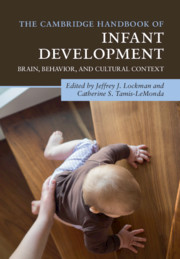Book contents
- The Cambridge Handbook of Infant Development
- The Cambridge Handbook of Infant Development
- Copyright page
- Dedication
- Contents
- Illustrations
- Contributors
- Preface
- Part I Foundations
- Part II Perceptual Development
- 6 Visual Development
- 7 Infant Visual Attention
- 8 Infants’ Perception of Auditory Patterns
- 9 The Development of Touch Perception and Body Representation
- 10 The Development of Infant Feeding
- 11 The Development of Multisensory Attention Skills
- Part III Cognitive Development
- Part IV Action
- Part V Language
- Part VI Emotional and Social Development
- Index
- References
7 - Infant Visual Attention
from Part II - Perceptual Development
Published online by Cambridge University Press: 26 September 2020
- The Cambridge Handbook of Infant Development
- The Cambridge Handbook of Infant Development
- Copyright page
- Dedication
- Contents
- Illustrations
- Contributors
- Preface
- Part I Foundations
- Part II Perceptual Development
- 6 Visual Development
- 7 Infant Visual Attention
- 8 Infants’ Perception of Auditory Patterns
- 9 The Development of Touch Perception and Body Representation
- 10 The Development of Infant Feeding
- 11 The Development of Multisensory Attention Skills
- Part III Cognitive Development
- Part IV Action
- Part V Language
- Part VI Emotional and Social Development
- Index
- References
Summary
From the moment infants open their eyes, they are confronted with a continuous stream of objects, people, sounds, and events that comprise their world. Some are adaptive to attend to and others are not (Gibson, 2000; Werchan & Amso, 2017). They will rely heavily on these observations to build the internal representations that will shape their future behavior. In this chapter, we review the development of infant visual attention, and the role this development plays in the remarkable achievements of infancy.
Keywords
- Type
- Chapter
- Information
- The Cambridge Handbook of Infant DevelopmentBrain, Behavior, and Cultural Context, pp. 186 - 213Publisher: Cambridge University PressPrint publication year: 2020

